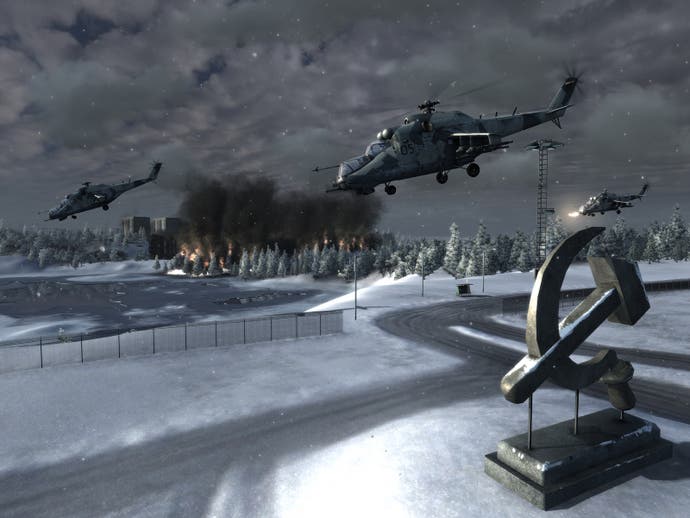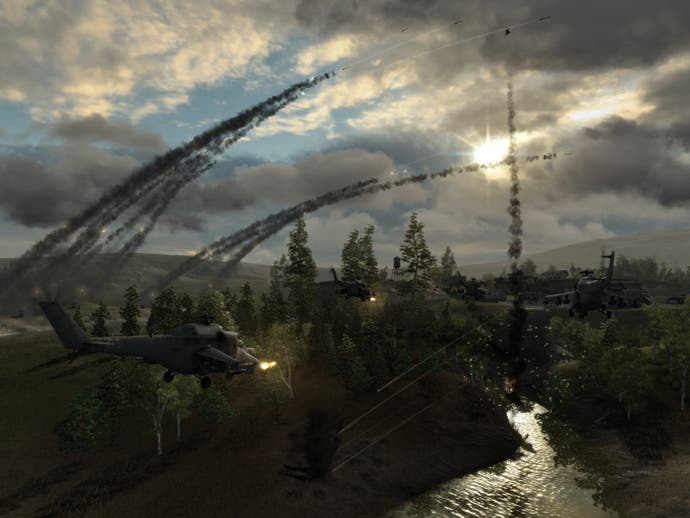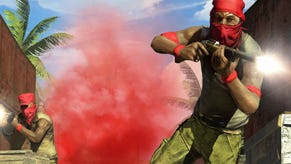World in Conflict
In our time, no foreign army has ever occupied American soil. Until now.
World in Conflict started life two years ago as a multiplayer concept: specifically, it was born from the desire to recreate the accessibility of first person deathmatch games but in a real-time strategy game. The game's developer, Massive Entertainment, wanted to create an RTS title that's as easy to pick up and play as an FPS, and the key to doing that, it reckoned, was to emulate the respawn function that's a hallmark of most arena combat games. And it's this that gives the game its defining characteristic: when your units die, the credits they cost to produce are returned and can be used again to produce further reinforcements. Thus, every player has the same amount of resources and is competing on a totally level playing field.
That playing field is set in an alternate vision of history devised by "Cold War authority and best-selling author" Larry Bond. Set in 1989, it sees the Soviets invading Europe and America, and single-player missions range across the French countryside, small town and farming communities across America and even into major cities such as Seattle.
The single-player campaign puts the player in charge of US forces and borrows from FPS titles in other ways too. Just as games like Call of Duty or Medal of Honor strive to create the sense of a real-life battlefield that's just one part of a much greater conflict, World in Conflict casts players as just one commanding officer of several. "In single-player we really want to take a more emotional aspect where you feel you are part of a bigger war," says Massive's CEO, Martin Walfisz. "That has been something really important for us to convey. You're not controlling every friendly unit on the battlefield. You're actually just controlling part of the force on the battlefield and you're being ordered by your commanding officer. On top of that the you're hearing the constant banter and chat and discussion between all of the different characters."

Thus each mission will see you co-operating with several other AI officers who will come to your aid or even make mistakes and call for your assistance. Fleshed out by dialogue composed by a 'Hollywood TV writer', the cast of characters includes Colonel Sawyer, a gruff ex-retired general who probably likes the smell of napalm in the morning; Bannon, an insecure Westpoint graduate; and the player character, Parker. A recent hands-on session provided a glimpse of how the battlefield chatter adds to the sense of atmosphere as Bannon struggled to capture a supermarket.
The hands-on session started, though, with Tears for Fears on the radio. It quickly went downhill from there as small town America was engulfed by chaos and Parker is given his first task: to secure a gas station (and maybe eliminating a sniper on the way). Apart from the battlefield banter, it also provided a good idea of how the resource system works: sending in reinforcements is as simple as selecting them from a drop down menu. They're then parachuted in to a drop zone (that you can move as you acquire territory). And as units are destroyed your resource points will start to trickle back, accelerating to a bit of a flood as more of your units are eliminated.

Taking over the gas station is done by securing key points around its perimeter, and unit selection and camera control is smooth and flexible throughout. Another aspect that the demo highlighted is the importance of flanking manoeuvres because most units have weaker armour at the rear - just as their real-world counterparts do, of course. But the ease of control and infinite supplies of reinforcements do raise one question: how will Massive make sure that players can't simply grind out mission objectives by throwing successive waves of soldiers at them? Well, armchair generals will be required to use the correct tactics, and some missions will require you to keep certain units alive, or to complete objectives within a time limit.
"In a way it allows us to create different experiences throughout the campaign," says Walfisz. "Each map can be different so it's not just about wiping out all the enemies."
Indeed it's not. It's also about making clever use of the game's massively destructive environments. Massive reckons the game engine is the "best RTS engine on the market". It can zoom in from a satellite view to an FPS-style close-up (complete with soldier-level dialogue), and while it supports all the latest DX 10 doowhizzery, it also scales right down to antique level cards like the GeForce 4Ti and ATI 9250 cards. It uses Havok 4.5 for its physics and gets a performance boost out of multi-processors. It's got advanced water shaders, dynamic animated sky and all those other things that developers say and about two per cent of readers understand.

Where the technology starts to have an impact on the actual game beyond just looking pretty and sounding complicated is in the game's totally destructible environments. The more damage you do, the more moody the atmospheric effects: so, clouds darken, and smoke starts smouldering from burned-out buildings. That's still just looking pretty though. But burning down forests or destroying buildings can have strategic implications as you open up line of sight for your soldiers, or create new routes for them to access other parts of the map.
Technology also plays a role in the game's multiplayer modes in the shape of AI bots that can respond to specific requests for help, and the whole thing is built around the notion of team play. Default matches last 20 minutes, featuring up to 16 players in teams of eight, and participants pick from specialised roles that allow access to different unit types: Infantry, Armor, Support Forces, or Aerial specialists. It's exactly the sort of thing that will reward repeated online play.
"We really want to create a new very accessible and emotional single-player experience and a new accessible multiplayer experience," concludes Walfisz. "And we've put a lot of effort into both. I really hope that the gamers who'd normally just play single player will also get excited about the new innovations that we have included in multiplayer and actually start playing online even if they haven't done it before. We really hope it will get single player gamers moving online."


